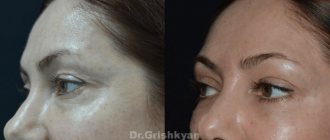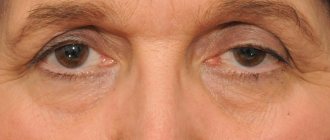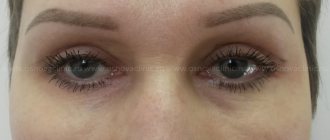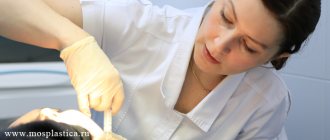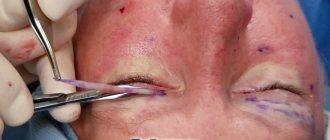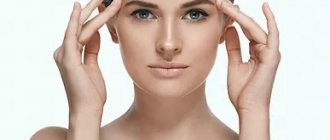So, we have learned everything about rehabilitation after different types of blepharoplasty. We talked in detail about how recovery occurs day by day.
Today I want to summarize everything that I told you. And write down point by point: what cannot be done after blepharoplasty, and what can be done.
Naturally, I will not talk about simple truths. I think you yourself know that you should not rub your eyes, feel your stitches, play sports or use cosmetics. And you even know why.
I will explain the remaining prohibitions, which often raise a lot of questions among patients.
Medications
In almost every article about preparing for surgery or rehabilitation, I talk about how important it is to tell your doctor about all the medications you are taking.
Why?
Some medications may affect the outcome of surgery. Some may cause the procedure to be prohibited. This is especially true for drugs that affect the blood.
Why is it important to remember this after blepharoplasty?
The plastic surgeon will prescribe the necessary medications for you. Painkillers, at a minimum, if necessary.
He will also inform you about when it will be possible to return to the medications that you took before preparing for the procedure.
But the most important thing: if after the rehabilitation period you feel unwell, caught a cold, or received severe bruises, the surgeon will coordinate the use of appropriate medications. It is very important. Because there remains a risk of complications, including those associated with medications.
Rehabilitation after blepharoplasty
Many women follow the personal lives of Hollywood stars with admiration and quiet envy.
In fact, popular divas are constantly in the spotlight - they change lovers, get married and divorced, give birth to children, star in dozens of films, go on concert tours... And at the same time they always and everywhere look stunning: smooth young skin, expressive eyes, slim figure, mane of luxurious hair. If their appearance changes over the years, it is only in the direction of even greater grooming and calculated beauty. But many of them are not so young - few manage to achieve fame at a young age. Real world fame comes when an actress or singer crosses the thirty or even forty-year mark. Just remember Madonna, Jennifer Lopez or Demi Moore. These ageless beauties quickly change husbands and lovers, and each time their new lover is younger and younger.
What is this? Outstanding natural abilities, excellent genetics or a special diet? No matter how much the star talks in her interviews about discipline, self-care and regular exercise, all this will do little to help avoid the natural aging of facial skin. Each of these women has a secret friend - a qualified plastic surgeon. Only through regular aesthetic procedures in adulthood and with a crazy lifestyle do they manage to maintain a fresh face.
But ordinary women who do not dream of world fame are also quite capable of getting rid of the most obvious signs of age - loss of skin elasticity, bags under the eyes or wrinkles in the eye area. To do this, you just need to perform eyelid surgery or blepharoplasty.
Blepharoplasty photo
You can see photos before and after blepharoplasty on the website of the Abrielle plastic surgery clinic in the Photo Gallery section.
What is blepharoplasty? This is an aesthetic surgery technique aimed at excision of excess skin, fatty hernias around the eyes and bags under the eyes, changing the shape of the eyelid or the shape of the eyes. Blepharoplasty or eyelid surgery is a small operation on the scale of the face, but significantly rejuvenating, because... The eye area, as a rule, is one of the first to reveal the number of years lived. That is why it is one of the most common and successfully tested techniques in the arsenal of plastic surgery.
Objectives of blepharoplasty
- excess skin of the upper and lower eyelids;
- wrinkles due to skin stretching;
- fatty hernias (bags) above and below the eyes;
- change in the shape and shape of the eye in the presence of an Asian eye shape.
For an experienced plastic surgeon, the operation is not difficult and can be performed even under local anesthesia, which allows you to transform your appearance even if you have heart problems or other contraindications to anesthesia.
The operation itself takes 1-2 hours and is performed under local or general anesthesia.
Many patients are concerned: what awaits after blepharoplasty? The main stage - the operation - has been completed, but now it is necessary to properly go through the recovery (aka rehabilitation) period, the nature of which may affect the quality of the result obtained.
It must be remembered that blepharoplasty is, although a low-traumatic procedure, still an operation, so first of all, you need to be prepared for the fact that after the operation there will be bruises and swelling on the face. These are completely normal phenomena, which, moreover, doctors know how to control and reduce to a minimum with special drugs, creams and procedures.
Rehabilitation after blepharoplasty reviews
“Special thanks to cosmetologist Ksenia Vasnina - attentive and sensitive, who helped me with my rehabilitation every day. I express my special gratitude to the plastic surgeon Ilona Sergeevna Kochneva for performing such a complex operation: tummy tuck + 6 liposuction zones + upper blepharoplasty. Thanks to the nurses who were always there in every difficult moment. I wish the Abrielle plastic surgery clinic prosperity, more clients to whom you will give aesthetic beauty, and the return of clients who have already undergone operations to your clinic for new wishes.” Natalya, 34 years old and other reviews about rehabilitation after blepharoplasty at the Abrielle aesthetic surgery clinic.
Sun, solarium and sauna
During the rehabilitation period you cannot:
- Be in direct sunlight.
- Sunbathe in the solarium.
- Visit baths and saunas.
- Swim in the pools.
Ultraviolet radiation is a necessary and inevitable part of life. Thanks to ultraviolet radiation, vitamin D is synthesized, other chemical reactions occur in the body, immunity increases, and mood improves. But it is no longer news that ultraviolet radiation can cause harm to living tissues. Therefore, a number of postoperative restrictions are associated with it.
Any plastic surgeon will recommend that you not only refrain from visiting beaches and solariums, but also wear sunglasses constantly for six months.
Why are baths and saunas dangerous?
When visiting such places, there is a risk of catching an infection or simply catching a cold (this also applies to swimming pools).
And, more importantly, when visiting such places, the body heats up. Blood vessels dilate. This contributes to increased swelling. And it can provoke a deterioration in the patient’s well-being.
Rehabilitation after lower eyelid surgery by day
The rehabilitation period can be divided into two periods: the early period and the late period.
Early rehabilitation lasts approximately half a month.
For the first three days of the recovery period, you will have to wear a special plaster, which the surgeon glues to the stitches.
During these days, most patients experience discomfort due to severe swelling and bruising under the eyes.
To prevent swelling from becoming too great, cold compresses should be applied to the eyes for the first hours after the procedure.
When the patch is removed, the doctor treats the stitches with special antiseptic preparations. This is done so that the wound heals faster and does not get infected.
At this point, the doctor prescribes eye drops and special ointments that should be used to regularly treat the eyes. When the suture is completely healed, you are allowed to do eye exercises and light massage at the incision site.
Since our clinic uses self-absorbing threads, there is no need to remove sutures.
During the first week, patients often experience tolerable pain. To reduce pain, the doctor prescribes painkillers.
Swelling goes away already on the 9-10th day, and bruises completely disappear after 2 - 3 weeks.
Limitations in the early period of rehabilitation
During the first two weeks after surgery, a person must do everything to prevent swelling from increasing. This means that you need:
- Sleep with your head slightly elevated on your back
- Apply cold compresses
- Avoid eating very salty, spicy, sour and fatty foods
- Do not drink alcohol (especially carbonated drinks)
- No smoking
- To prevent your eyes from becoming overtired, you should stop watching TV, reading books, or working on the computer for a while.
- When washing, you should use mild soap and it is important to do this very gently. During the first week, you should never touch your eyelids. You need to wipe your face very carefully, simply soaking the towel.
- Under no circumstances should you bend over or be exposed to heavy physical exertion. This can lead to serious complications.
- You can wash your head by tilting it back (maybe ask someone from your family to help)
- You cannot take a hot shower, go to the bathhouse or visit the sauna.
- Don't drink too much or too little liquid. It is better to give up coffee during this period.
In order to prevent infection of incisions, you must adhere to the following rules:
- During the first days, you should not touch the seams with your hands often.
- Don't get the wound wet
- You can't swim in the pool
- Sutures must be regularly treated with antiseptics, which will be prescribed by the doctor.
- For the first 14 days you should not apply makeup to your face.
- You can use herbal infusions to wash your face
To ensure that the procedure does not affect vision, it is important:
- Moisturize your eyes with special drops
- Wear sunglasses
- Avoid contact lenses
Late rehabilitation period
After three weeks it will be possible to return to the normal rhythm of life. At this time, you need to continue to massage the sutures so that noticeable scars do not form.
Complete healing occurs within one and a half to two months. In difficult cases, rehabilitation may take longer.
When do sutures heal after upper eyelid surgery?
The stitches are tightened after ten days. When they have healed well (on the fifteenth day), you can and even need to do a special eyelid massage and eye gymnastics. As a result, after two months the scar will be practically invisible. In some cases it takes longer.
The speed of healing of sutures depends not only on the skill of the surgeon and the extent of the surgical intervention, but also on the patient himself. In older people, healing is slower than in younger patients. If you do not take the rules of conduct during rehabilitation seriously, there is a possibility that the sutures will become inflamed and this will slow down the recovery process.
What care is needed during the recovery period?
If you take proper care of your eyes, you can avoid many unwanted complications. This care includes:
- Gymnast for the eyes
- Eyelid massage
- Physiotherapeutic procedures
- The use of ointments that help improve blood circulation and skin regeneration. The stitches need to be coated with ointment, which was prescribed by the surgeon.
On plastic surgery forums, patients share that they used hydrocartisone ointment. And to reduce bruises they used Sinyakoff ointment.
Don't strain your eyes
Another group of prohibitions concerns gadgets, TV and even books.
Once during a consultation I was asked: “What, after blepharoplasty I shouldn’t look at my phone, play on a tablet or even watch TV for a month?!”
Of course not! We are talking about the need to reduce contact with technology and books, and not about a complete ban.
Firstly, our age involves close contact with gadgets. There is no escape from it.
Secondly, there is no point in a complete ban. We are not restoring vision, but removing imperfections of a different kind.
You just need to use smartphones minimally. Don’t scroll through the news feed for an hour, don’t watch TV series, don’t read e-books.
Your eyes need rest.
Bad habits
Alcoholic drinks and cigarettes are two problems that, unfortunately, are familiar to a very large number of my patients.
No matter how long I talk about their harmful effects on the body. No matter how much you talk about the risks. All the same, heavy smokers relapse. And many believe that “two sips will do nothing at the holiday.”
Once again I urge you to be patient. Rehabilitation after blepharoplasty does not last a year, or even six months.
Avoid cigarettes and alcohol for at least a month. And enjoy your rejuvenated, refreshed eyes!
Here you can make an appointment with me for a consultation. I will be happy to answer your questions!

